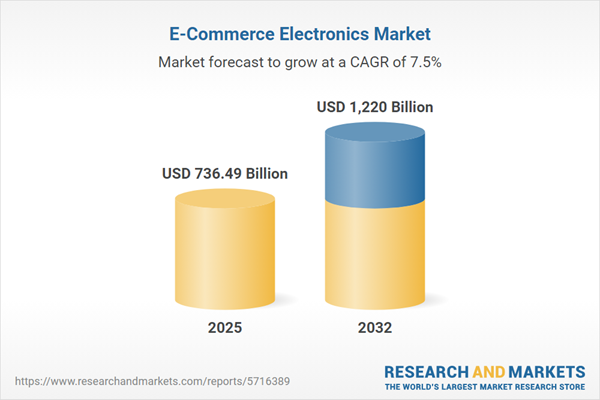Speak directly to the analyst to clarify any post sales queries you may have.
The e-commerce electronics market is undergoing a dynamic transformation, led by shifting consumer behaviors, evolving supply chains, and innovative retail models. Staying ahead requires robust intelligence on competitive trends, regulatory factors, and technology adoption that are shaping the industry for enterprises and stakeholders.
Market Snapshot: E-Commerce Electronics Market Overview
The global e-commerce electronics market grew from USD 687.28 billion in 2024 to USD 736.49 billion in 2025 and is projected to expand at a CAGR of 7.48%, reaching USD 1.22 trillion by 2032.
This momentum reflects increasing consumer appetite for online procurement of laptops, smartphones, wearables, and similar devices. Demand is influenced by digital innovation, seamless user journeys, and an accelerated shift toward omnichannel engagement. Industry expansion is further bolstered by emerging purchase models, direct-to-consumer platforms, and responsive value chain strategies that support both B2B and B2C segments.Scope & Segmentation
This comprehensive market research provides an in-depth analysis based on several critical parameters, offering actionable perspective for senior decision-makers.
- Product Types: Accessories (chargers, headphones), consumer electronics (air conditioners, refrigerators, speakers, TVs, washing machines), laptops & PC, mobile phones & tablets, networking devices (modems, routers), wearables (fitness bands, smartwatches).
- Price Ranges: Low end, mid-range, premium.
- End User Segments: Business/commercial (including large enterprises, small & medium enterprises), individual consumers.
- Distribution Channels: Company websites, third-party platforms.
- Geographic Coverage: Americas (United States, Canada, Mexico, Brazil, Argentina, Chile, Colombia, Peru), Europe, Middle East & Africa (United Kingdom, Germany, France, Russia, Italy, Spain, Netherlands, Sweden, Poland, Switzerland, UAE, Saudi Arabia, Qatar, Turkey, Israel, South Africa, Nigeria, Egypt, Kenya), Asia-Pacific (China, India, Japan, Australia, South Korea, Indonesia, Thailand, Malaysia, Singapore, Taiwan).
- Leading Companies: Amazon.com, Walmart, Alibaba Group, Apple, Best Buy, Costco Wholesale, Digitec Galaxus, eBay, Flipkart, Groupon, JD.com, LG Electronics, Newegg Commerce, Reliance Retail, Samsung Electronics, Suning.com, Target, Sony Group, Canon, Koninklijke Philips, Panasonic, Xiaomi, Dell Technologies, Etsy.
E-Commerce Electronics Market: Key Takeaways
- Adoption of omnichannel strategies is redefining consumer reach, with leading brands investing in seamless digital and in-person experiences for buyers.
- Artificial intelligence and augmented reality are becoming embedded within the consumer journey, supporting personalized recommendations and virtual product trials.
- The rise of subscription and device-as-a-service models is driving loyalty, recurring revenue, and new monetization approaches beyond traditional product sales.
- Sustainability is establishing itself as a key differentiator, with manufacturers and retailers integrating recycling, refurbishment, and eco-friendly initiatives across the product lifecycle.
- Companies embracing data-driven decision frameworks and flexible supply partnerships are better positioned to adapt to volatility and maintain service levels.
- Regional dynamics shape market opportunities, as factors like regulatory frameworks, payment infrastructure, and consumer preferences directly influence sales strategies.
Tariff Impact: Navigating Shifting Trade Conditions
Recent U.S. tariff adjustments have shifted market dynamics by affecting the cost structure for electronics imported from key production centers. These changes have prompted some suppliers to absorb costs, while others have passed increases to buyers—affecting procurement strategies and demand in sensitive segments. Supply chain networks are responding by diversifying manufacturing footprints, nearshoring, and renegotiating long-term contracts to minimize exposure and boost resilience amid tariff volatility.
Methodology & Data Sources
This report leverages a combined approach, with primary data collected through structured executive interviews across manufacturers, logistics firms, and digital platforms. Comprehensive desk research from public filings, regulatory disclosures, trade statistics, and industry media supports qualitative analysis. Insights are validated using survey data from senior stakeholders and cross-referenced with shipment statistics to ensure accuracy and depth.
Why This Report Matters
- Enables senior leaders to identify high-impact opportunities and emerging threats across the value chain.
- Delivers actionable segmentation by product type, region, and distribution strategy—facilitating data-driven market entry and expansion plans.
- Equips decision-makers to anticipate the effects of regulatory changes, sustainability trends, and evolving digital commerce models within the electronics sector.
Conclusion
The e-commerce electronics market is reshaping itself in response to digital, regulatory, and consumer shifts. Industry stakeholders who harness actionable intelligence will outpace disruption, ensuring continued growth and relevance.
Additional Product Information:
- Purchase of this report includes 1 year online access with quarterly updates.
- This report can be updated on request. Please contact our Customer Experience team using the Ask a Question widget on our website.
Table of Contents
3. Executive Summary
4. Market Overview
7. Cumulative Impact of Artificial Intelligence 2025
Companies Mentioned
The companies profiled in this E-Commerce Electronics market report include:- Amazon.com, Inc.
- Walmart Inc.
- Alibaba Group Holding Limited
- Apple Inc.
- Best Buy Co., Inc.
- Costco Wholesale Corporation
- Digitec Galaxus AG
- eBay Inc.
- Flipkart Private Limited
- Groupon, Inc.
- JD.com, Inc.
- LG Electronics Inc.
- Newegg Commerce, Inc.
- Reliance Retail Ltd.
- Samsung Electronics Co., Ltd.
- Suning.com Co., Ltd.
- Target Corporation
- Sony Group Corporation
- Canon Inc.
- Koninklijke Philips N.V.
- Panasonic Corporation
- Xiaomi Corporation
- Dell Technologies
- Etsy, Inc.
Table Information
| Report Attribute | Details |
|---|---|
| No. of Pages | 197 |
| Published | November 2025 |
| Forecast Period | 2025 - 2032 |
| Estimated Market Value ( USD | $ 736.49 Billion |
| Forecasted Market Value ( USD | $ 1220 Billion |
| Compound Annual Growth Rate | 7.4% |
| Regions Covered | Global |
| No. of Companies Mentioned | 25 |









